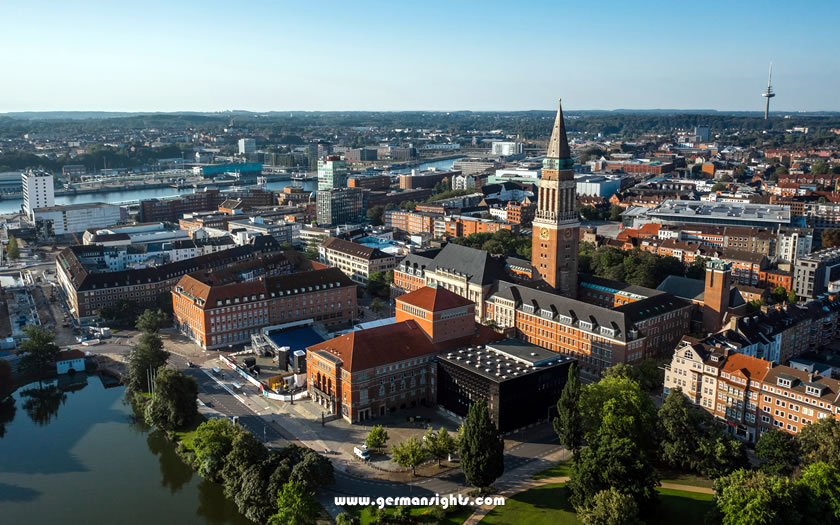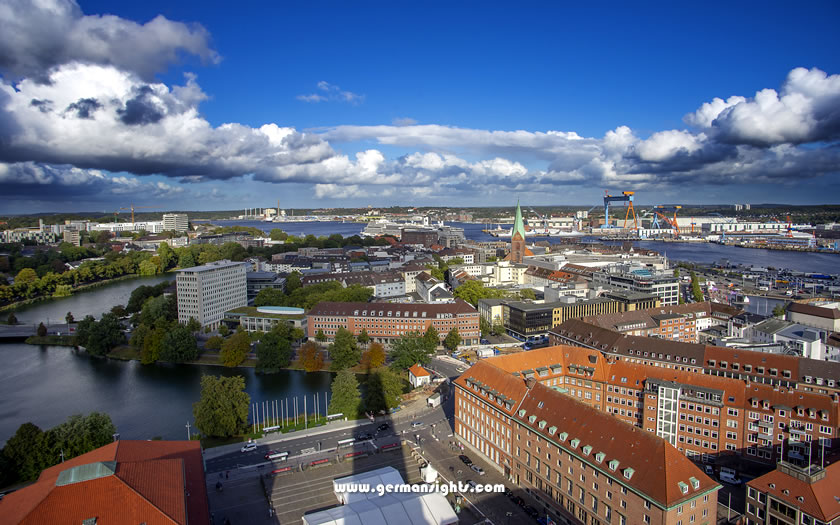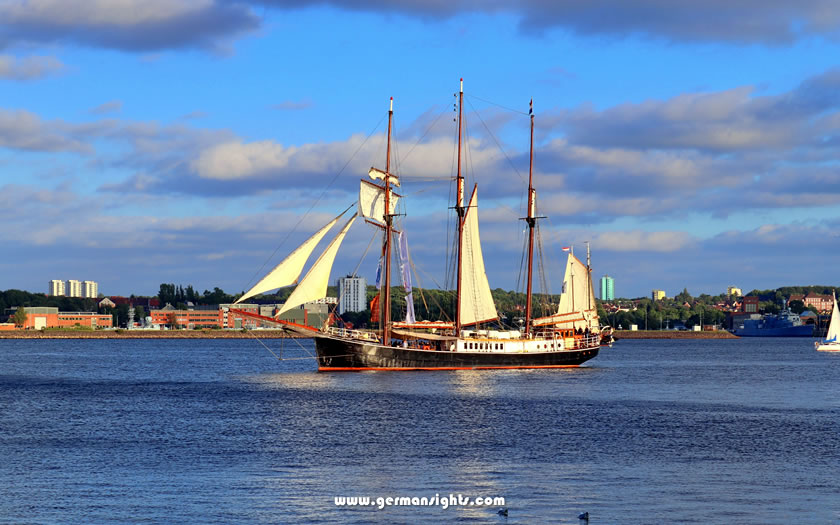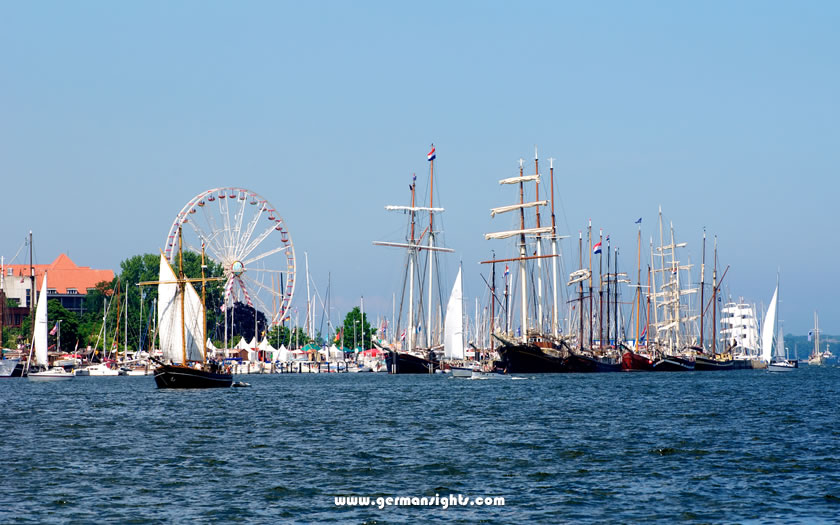Kiel is the maritime heart of northern Germany, where sailing tradition meets present-day naval power.
As the capital of Schleswig-Holstein, this city of 250,000 offers an authentic German coastal experience without the tourist crowds of more prominent ports. The city's identity revolves around its 17-kilometre-long fjord, which serves as both a major shipping lane and a recreational paradise.
Kiel has a more contemporary feel, unlike many German cities with their medieval architecture. World War II reconstruction created wide boulevards and functional buildings, while recent waterfront development has transformed industrial areas into bustling public spaces.

Aerial view over the centre of Kiel
This modern character, while initially surprising to visitors expecting traditional German charm, allows the city to focus on its true strengths: maritime culture, outdoor recreation and scientific innovation.
The annual Kieler Woche, the world's largest sailing event, demonstrates Kiel's continuing relevance to global maritime culture. For one week in June, the city plays host to over three million visitors who come to watch 2,000 ships compete and take part in the surrounding festival.
During the rest of the year, Kiel maintains a steady rhythm as a university town and working port, offering visitors a real glimpse of life in northern Germany.
Kiel is best suited to travellers interested in maritime history, outdoor activities and experiencing a German city that prioritises function over tourist appeal.
The surrounding region offers easy access to both the North and Baltic Seas, making Kiel an excellent base for exploring the coastal landscapes and culture of northern Germany.
Kiel occupies a strategic position at the eastern end of the Kiel Canal, where the Baltic Sea flows inland to form the Kiel Fjord. The city is approximately 90 kilometres north of Hamburg and 320 kilometres northwest of Berlin. This location has historically made Kiel an important link between the Baltic Sea and the North Sea.
The city extends over both sides of the fjord, with the main city centre on the western shore. To the east, the district of Gaarden-Ost is home to the famous HDW shipyards, while the northern districts of Holtenau and Friedrichsort guard the entrance to the Kiel Canal.

View over Kiel harbour
Kiel's location makes it an ideal gateway to Scandinavia, with regular ferry services to Oslo, Norway and Gothenburg, Sweden. The Danish border is just 100 kilometres to the north, making Copenhagen an easy day trip. To the west, the North Sea coast and its famous Wadden Sea National Park are less than two hours away by car or train.
The city's location also influences its climate. The Baltic Sea moderates temperature extremes, resulting in cool summers and relatively mild winters for its northern latitude.
Maritime influences bring consistent rainfall throughout the year, with slightly more precipitation during the summer months. This climate supports the region's characteristic landscape of beech forests and rolling farmland.
Hamburg airport is easily the closest and most convenient option for those wanting to travel to Kiel. It has plenty of European carriers and destinations, although a limited number of long-haul flights.
Distance to Hamburg Airport: 89km
Distance to Lübeck Airport: 95km
Distance to Bremen Airport: 206km
Lübeck Airport is very small, and has a limited number of European scheduled and charter flights. The airport at Bremen does offer European destinations, but a wider choice is likely to be available at Hamburg.
Those looking for long-haul flights might be better served by flying in to one of the big German airports (Berlin or Frankfurt, for example) and then taking a domestic connecting flight.
The most efficient way to reach Kiel from within Germany is by train. The city's main railway station is conveniently located in the city centre with direct InterCity connections to Hamburg, Berlin and Frankfurt. Deutsche Bahn's reliable services include both high-speed ICE trains and regional rail routes, with the Hamburg-Kiel stretch running from early morning to late evening.
Kiel is linked to Germany's excellent motorway network via the A7 and A215 motorways. The drive from Hamburg takes about an hour, while Berlin is about four hours away.
During Kiel Week in June, drivers should expect heavy traffic and limited parking in the city centre. Several well signposted park and ride facilities on the outskirts of the city provide a convenient alternative during busy periods.
Another way to get to Kiel is by ferry. Color Line and Stena Line operate regular services from Oslo and Gothenburg respectively, with modern vessels offering both overnight cabins and day crossings. These ferries dock at the Norwegenkai and Schwedenkai terminals, both within walking distance of the city centre. Local buses connect the ferry terminals with the Central Station and other parts of the city.
If you know when you are planning to go but haven't decided on accommodation, then use the map below to get an idea of which properties are available and to compare prices during the period you wish to travel.
Enter your proposed dates and use the '+' to zoom in on a location and reveal more properties. Click on the price above a property to see more information.
(Please note that this selection will also include some guesthouses, pensions and self-catering apartments for those who are interested in that form of accommodation!)
Alternatively, if you would like a list of properties available on your proposed dates of travel, use the search box below to find accommodation:
Kiel's history began as a modest Viking settlement in the 13th century, though its transformation into a major maritime center didn't occur until 1242, when Adolf IV of Holstein granted it city rights.
The town's natural harbour and strategic location gradually established its importance in the Hanseatic League, although it remained smaller than neighbouring trading powers such as Lübeck.
The decisive change came in 1865 when Kiel became a Prussian naval base. This change triggered rapid industrialisation and urban growth as the shipyards expanded and the naval academy attracted military personnel.
The opening of the Kiel Canal in 1895 (then called the Kaiser-Wilhelm Canal) further cemented the city's maritime importance, providing a vital shortcut between the Baltic and North Seas.

Boats arrive for the Kieler Woche
The Second World War marked a devastating chapter in Kiel's history. As a major naval base and shipbuilding centre, the city became a prime target for Allied bombing. By 1945, around 80% of the city centre lay in ruins.
This destruction explains Kiel's modern appearance today - unlike many German cities that retained their medieval character, post-war reconstruction created a distinctly contemporary urban landscape.
The founding of Kiel University in 1665 added an academic dimension to the city's identity. Today, the university remains an important part of Kiel's character, with more than 27,000 students contributing to the city's lively, youthful atmosphere. The institution has become particularly prominent in marine sciences and climate research, reflecting the city's enduring connection with the sea.
Kiel's maritime heritage continues through Kiel Week (the 'Kieler Woche'), which began as a small yacht race in 1882. The event has grown into the world's largest sailing festival, attracting millions of visitors each June.
The Kiel Maritime Museum provides an important context for Kiel's maritime history through detailed ship models and maritime artefacts.
The U-995 submarine museum in Laboe presents a tangible piece of naval history, while the adjacent Naval Memorial offers panoramic views of the fjord.
The rebuilt centre of Kiel revolves around Holstenstrasse, the main shopping street running from the railway station to the waterfront. The Nikolaikirche, although rebuilt after the war, remains the city's most important historic church.
Kiel town hall has an accessible tower with views of the city. A weekly market brings local producers to the central square every Wednesday and Saturday.
The Kiellinie promenade is the recreational heart of the city, stretching 6.6 kilometres along the western shore. Here visitors will find seafood restaurants, beer gardens and frequent boat traffic. The Seegarten section has children's playgrounds and beach areas.
Regular passenger ferries cross the fjord, offering spontaneous mini-cruises and alternative views of the city.

Sailboats and ferris wheel at the Kieler Woche
The Kunsthalle presents northern German art and international exhibitions. The Opera House stages classical performances and modern productions.
The Computer Museum traces the evolution of technology through working exhibits. The Botanical Gardens, part of Kiel University, offer peaceful walks through various plant collections.
Cycle paths link the town to the surrounding beaches and natural areas. The Schilksee Olympic Centre, site of the 1972 sailing competitions, offers year-round water sports facilities.
The nearby Schwentine Valley offers hiking trails through typical North German countryside. In winter, indoor swimming pools and spa facilities maintain the city's aquatic focus.
Beside the major extravaganza of Kieler Woche in June, the city hosts several other events:
The Kieler Ford tourist office is located in the Neues Rathaus and is open all day Monday-Friday, with slightly restricted hours on Saturdays.
Website: kiel-sailing-city.de